Why is the pear rusty and what to do?

Rust is a dangerous disease that can affect a wide variety of plants in the area. Leaves are the first to suffer from this ailment. Pear most often suffers from rust. In this article, we will find out why this disease appears on the pear and how to deal with it correctly.
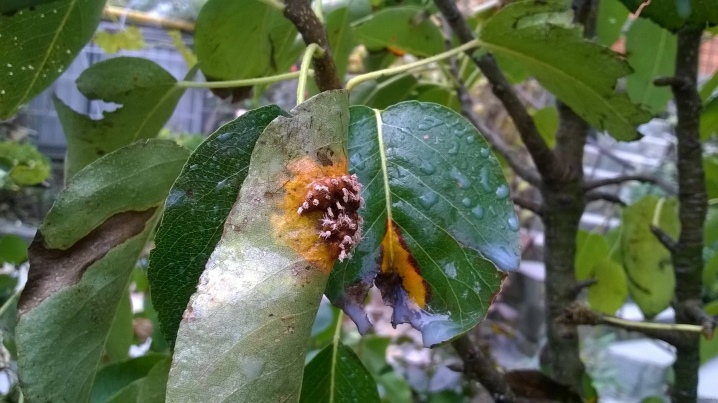
What it is?
First of all, it makes sense to understand what constitutes such a serious ailment as rust. The pathogenic fungus Gymnosporangium Sabinae acts as a provocateur of this disease. It is because of it that the plants become infected with rust.
The disease in question often affects garden fruit trees. It got its name due to the fact that the pathogen fungus contributes to the formation of affected foci on the leaf plates, the color of which is very similar to rust spots of a red or red-yellow hue.
After some time, the formed red, orange spots begin to grow in size. Leaves that have been affected by the disease become brown, and then completely fall off. The immunity of the pear against the background of such events is significantly reduced.
If absolutely no measures are taken to treat the fruit tree, then in a few years it will simply die.
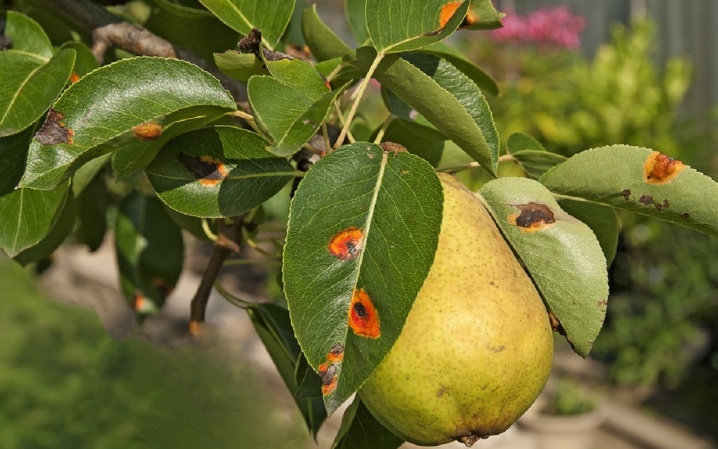
Reasons for the appearance
Often this dangerous ailment affects juniper and other coniferous plant varieties, as a result of which they act as the first carrier and spread of infection. Moreover, the juniper itself or another infected planting can be located far outside the suburban area and garden. Fungal spores can spread freely with liquids, with gusts of wind.
The main feature of the spread of a dangerous disease that forms brown and rusty dots on the leaf plates of plants is the cross-infection pattern. It should be borne in mind that the fungus does not pass from pear to pear or from one juniper bush to another. Spores that ripen towards the end of the summer season on the foliage of a fruit tree scatter, which is why they will certainly infect the same juniper. With the onset of next spring, the latter will have time to infect other plantings in the garden.
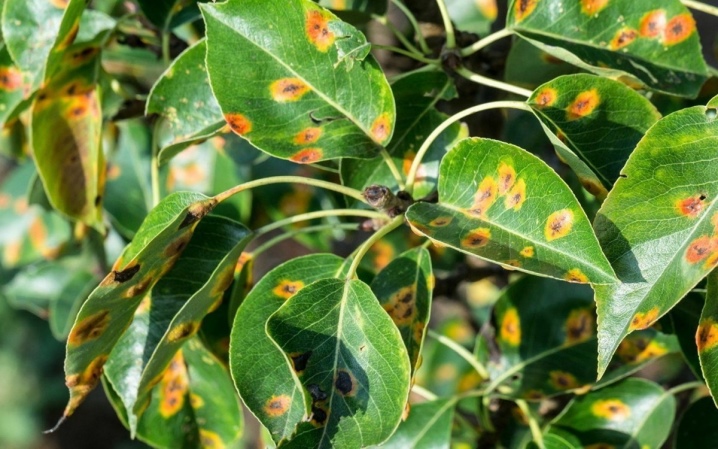
Summer residents should definitely know that it is necessary to take effective actions to treat plants as soon as possible.
As soon as the first signs of rust appear, it is necessary to begin the treatment of garden plantings. Rust usually develops very quickly. Already in the first few days after infection, small pimples appear on the foliage of the pear. They are constantly growing, soon covering the entire leaf plate. At the next stage, characteristic gray stains appear. Gardeners often confuse them with mold.
Further, on the back of the pear leaves, unusual tubercles appear in the form of small thorns. They have a conical structure and are colored red or red-brown. At this stage, the fruit tree is already a danger to other plantings in the garden. In the conical formations on the foliage, dangerous spores mature, which soon begin to scatter everywhere.
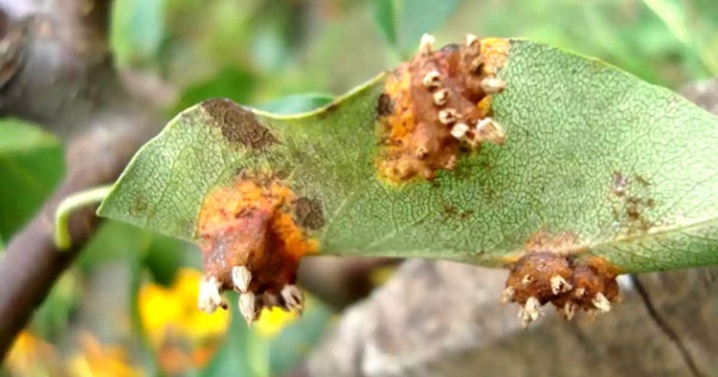
How and with what to process?
If red spots appear on the pear leaves, the fruit tree must be properly treated without fail. Currently, there are many effective techniques to get rid of such a nuisance. Some gardeners use special chemicals in the fight against rust, while others use proven folk remedies. Let's get acquainted with both the first and the second.
Folk remedies
There are many well-known folk remedies that can successfully fight rust that has struck a pear. So, in the fall, immediately after the completion of the leaf fall, the fruit tree can be sprayed with a specially prepared urea solution. To do this, dissolve 350 g of urea in 5 liters of clean liquid. Processing with such a composition demonstrates high efficiency in the fight against other common diseases.
It should be borne in mind that such an autumn processing must necessarily be carried out after the sun sets, or in cloudy daytime conditions. It is necessary to comply with this condition so that the leaves and bark of the pear do not receive burns from exposure to ultraviolet rays.
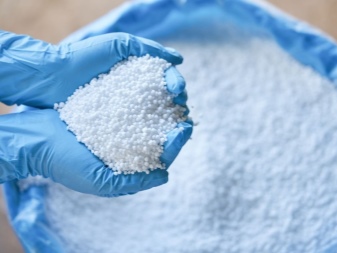
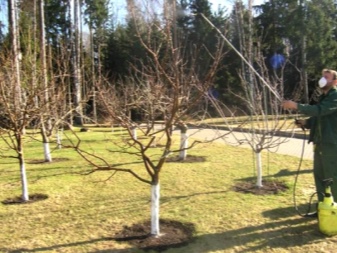
Rust treatment can be successful if another popular folk composition is prepared. You need to mix:
- 1 tbsp. l. baking soda;
- 1 tsp detergents with a liquid consistency;
- 1 tablet of crushed aspirin;
- 1 tbsp. l. salt;
- 4.5 liters of clean liquid.
Of all the listed components, a solution will be obtained, which will need to be sprayed weekly on pears affected by the fungal disease in question. It is especially recommended to turn to such a mixture when rust manifests itself at the moment when the fruit of the tree ripens.
After flowering, many gardeners process the pear with marigold tincture. For its preparation, small flowers, leaves and stems are poured with warm liquid. These components are insisted for two days. After that, laundry soap is added to the workpiece in the amount of 30-40 g per 10 liters of water. The soap is pre-grated.
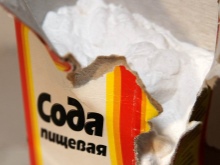
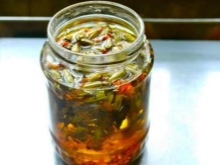
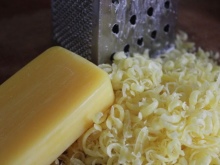
Store funds
It is possible to remove a dangerous growth on the leaves not only with folk, but also with store-bought means. Most often, the treatment of fruit trees suffering from rust is started in the fall. A good effect can be achieved if the pear foliage is treated with fungicides. Branches that show signs of a dangerous disease must be completely cut out. It is required to cut off even those shoots that are slightly damaged by the disease. The places left after cutting are also treated with fungicides, and then these areas are coated with garden varnish or melted wax. All the leaves that have already fallen, together with the cut branches, must be collected in one pile and burned.
Spring treatment of a diseased pear can demonstrate very good results. Similar procedures are performed in several stages. First, the tree is processed before the buds open, then during blooming, and then at the very end of flowering.
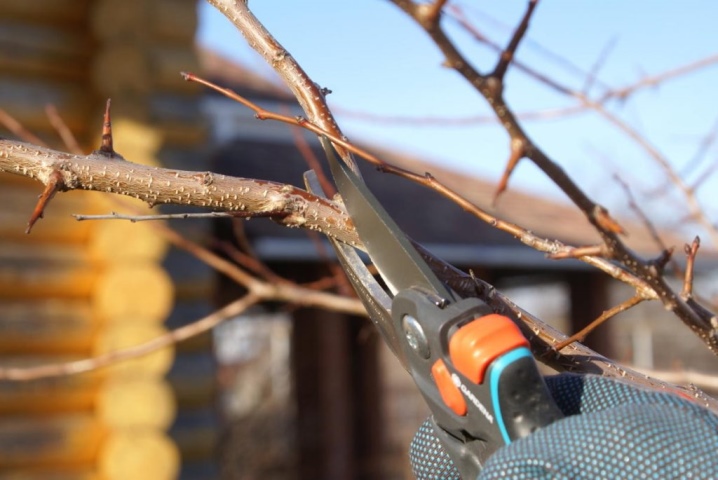
Chemicals that are used to treat pears for the fungal disease in question are divided into 2 main groups:
- new generation tools;
- drugs of the old model.
All varieties of effective drugs are made on the basis of such a simple component as sulfur. This component quickly stops the growth and development of the mycelium, prevents the formation of harmful spores.
There is another popular remedy proven over the years. It is popular among summer residents bordeaux liquid, as well as copper or iron sulfate. Colloidal sulfur is no less popular. The effectiveness of the listed components in the fight against rust is at an average level.
It makes sense to turn to such drugs if the fungal lesions are not too extensive and neglected. In addition, these funds are perfect for preventive measures.
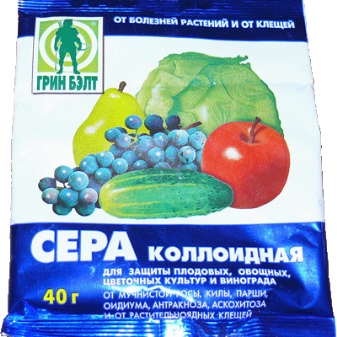
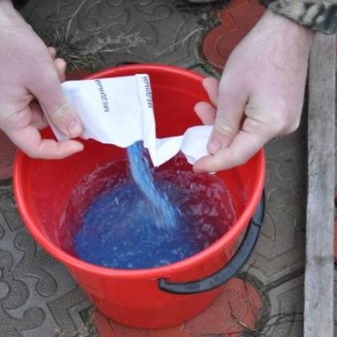
Modern varieties of preparations for horticultural crops fight dangerous fungi using substances that literally at the cellular level block the spread of fungal mycelium in the middle of the tree structure. Popular and widespread drugs of the latest sample include:
- "Speed";
- Horus;
- "Raek";
- Revus.
The lion's share of modern drugs based on chemicals are ineffective if the pathogen has already entered the spore wearing phase.In addition, rust fungi are able to quickly adapt to prolonged exposure to the same mixtures and formulations. That is why it is recommended to alternate the used chemicals periodically.
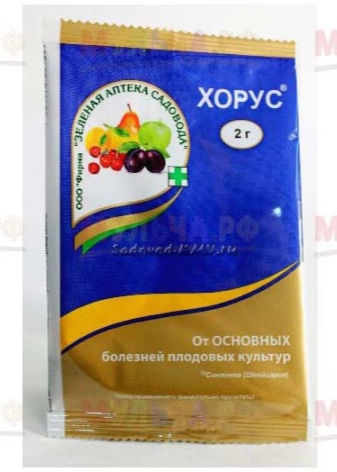
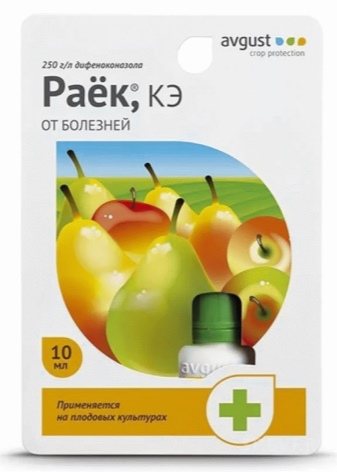
Prevention measures
There is no need to wait until a healthy fruit tree, carefully grown in the garden, has leaves with dangerous red spots and small needle-like processes. It is much easier to prevent such problems than to deal with them when they have already arisen. It is advisable to start preventive procedures against rust as early as possible.
It is best to act already at the stage of planting a fruit orchard tree. After that, every year from early spring to late autumn, it is necessary to thoroughly spray the plantings.
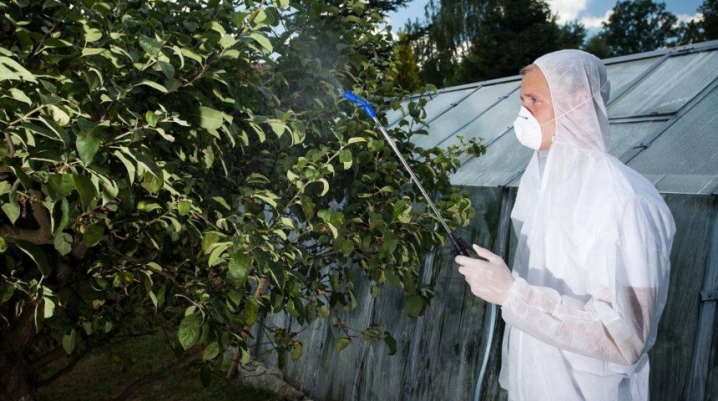
It will be possible to save the pear and other garden crops from dangerous rust if you resort to various preventive measures. Let's consider the most affordable and effective ones.
- It is necessary initially to carefully choose resistant pear varieties that have good immunity.
- Planting fruit trees on the site should be carried out as far as possible from the nearby juniper bushes. As soon as it was noticed that such shrubs were covered with small red spots, you need to immediately cut off absolutely all the branches that are already affected from them. After this, the cuttings must not only be thrown away, but burned.
- The grower must always keep under control the health of the planted fruit trees. It is important to regularly carefully inspect the pear leaf plates. And it is also required to monitor the bark of the tree in order to timely notice the appeared cracks, ulcers and other similar damage.
- It is imperative to cut and thin out the crowns of fruit plantations.
- In the spring and autumn seasons, it is always necessary to carry out preventive tree treatments. For these purposes, it is recommended to use a fungicide.
- It is recommended to treat pears in the garden with a special biological preparation called "Fitosporin-M". In one season, they carry out 4 treatments.
- An attractive hedge can be planted around the perimeter of the garden area. It will be able to effectively contain dangerous fungal spores moving through the air.
- For the purpose of prevention, you can turn to various folk remedies and methods. For example, it is permissible to spray a pear with a tincture made from horsetail, ash or marigolds.
If you turn to all of the listed preventive measures, then a fruit tree planted in a garden area will be more resistant to a dangerous fungal disease.
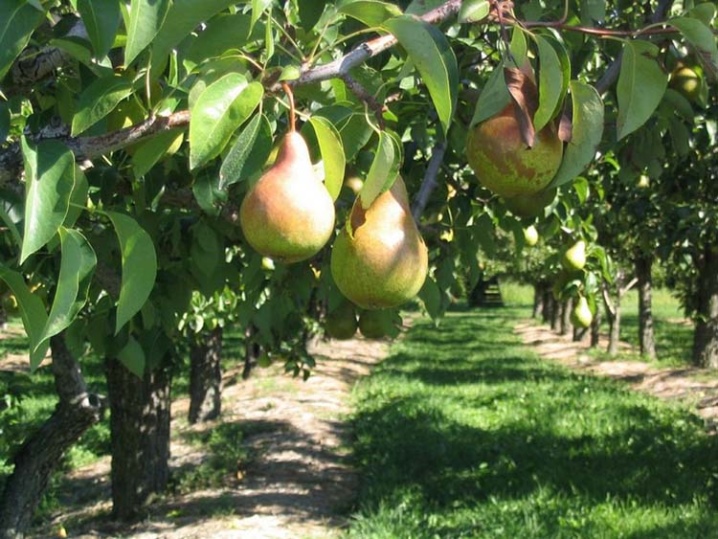
Resistant varieties
The pear is susceptible to many different diseases that differ in their origin. Often these fruit trees get sick not only with dangerous rust, but also with moniliosis or scab. However, varieties of pears have been bred that are resistant to the fungal disease in question.
"Dukhmyana"
This is the name of a medium-sized fruit tree. It has a crown with an average level of density. "Dukhmyana" has a wide pyramidal structure. It produces fruits of a green hue with a beautiful reddish blush. The fruit is pear-shaped. They have a smooth skin showing a beautiful shine.
The fruits of the pear variety in question have a snow-white pulp, characterized by oiliness. The taste is very pleasant, sweet and sour.
The variety is distinguished by high yield rates. It is resistant to bacterial cancers.
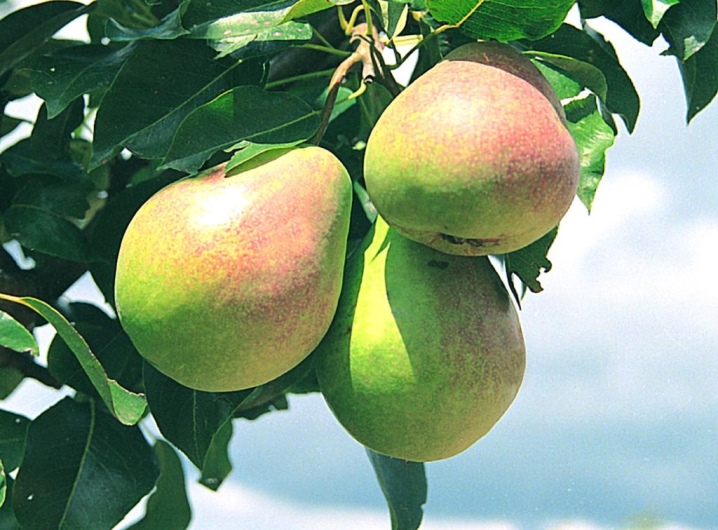
"Severyanka"
This fruit tree, like the one discussed above, is medium-sized. Its crown is medium-dense, has a wide-pyramidal structure. The fruits of this pear variety are not green, but yellow. They have characteristic green spots. Fruit sizes are relatively small.They have a truncated-conical shape.
The skin of this variety is denser. It does not give out shine, but, on the contrary, looks dimmer. The pulp has a creamy shade, it is characterized by an average degree of density.
The variety itself is attractive in that it is winter-hardy, gives a rich harvest, and is not afraid of most common diseases.
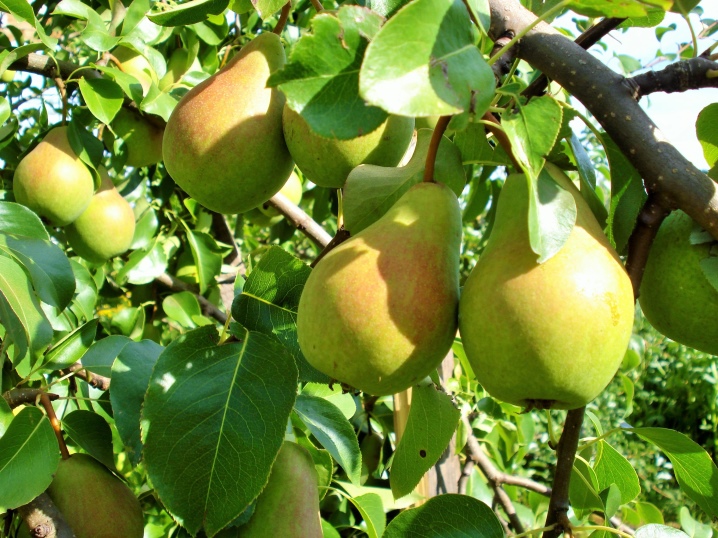
"Tikhonovka"
Fruit trees belonging to this variety are characterized by medium growth rates. Their crown can be either wide-pyramidal or round - it all depends on the age of the culture. The variety produces green and small fruits with an ovoid or wide pear-shaped shape.
The fruits of "Tikhonovka" have a rather tough and dense skin. The pulp has a yellowish tint, is very juicy, tasty and crunchy. The variety is winter hardy and completely undemanding in grooming procedures.
Produces a very rich harvest, is resistant to most common pear diseases.
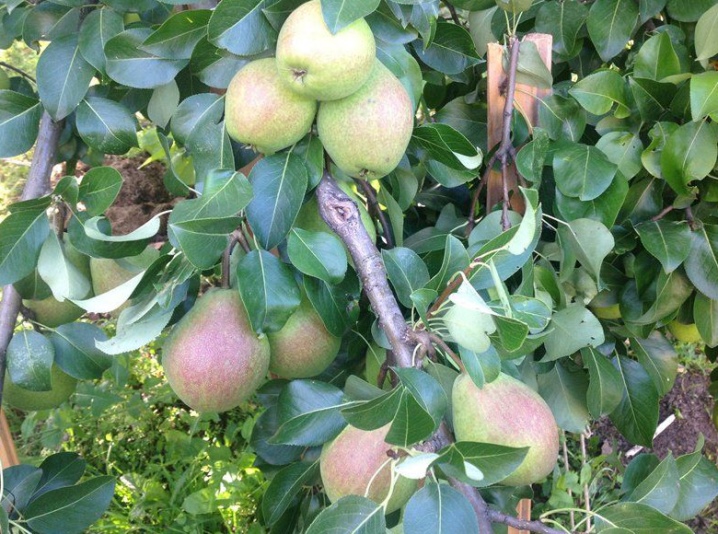
"In memory of Yakovlev"
Trees related to this variety are undersized. Their crown is characterized by medium density, has an attractive rounded structure. The fruits of such pears are yellow, have a slight pinkish blush. They reach medium size and are characterized by a wide pear-shaped shape.
The fruits produced by this culture have a thin skin that is distinguished by an appetizing shine and semi-oily appearance. The pulp of the fruit is creamy snow-white, juicy and soft.
This pear variety, like those discussed above, has a good yield, is not afraid of cold winters, does not require additional protection against most diseases, since it is resistant to them.
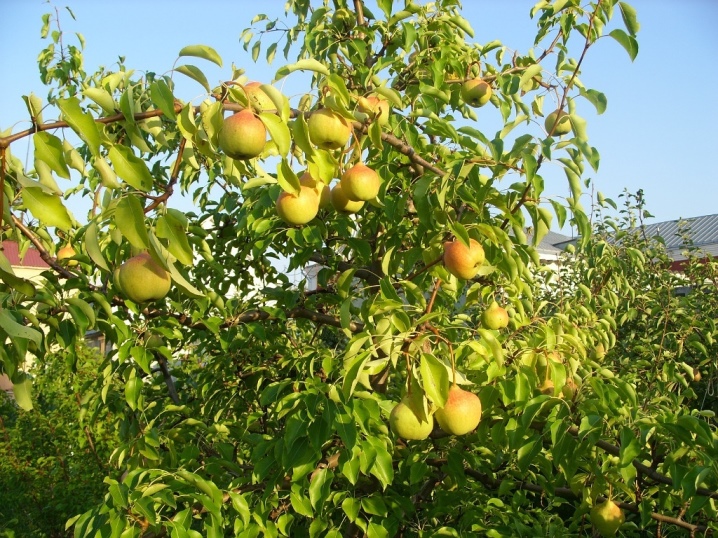
Unstable varieties
Before choosing which varieties of fruit trees to plant in your local area, you should find out which ones are unstable to rust. In those regions where there is a high risk of infection of the plantings with a fungal disease, it is strongly not recommended to grow varieties sensitive to the pathogen. These include the following names:
- "Favorite";
- "Klappa";
- "Curé";
- "Winter Dikanka".
Specialists refer to areas of especially high risk as those areas where juniper bushes are naturally widespread. We must not forget that it is these plants that most often turn out to be the cause of pear rust infection.
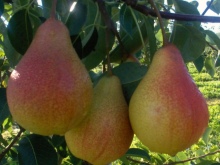
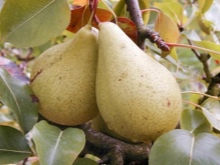
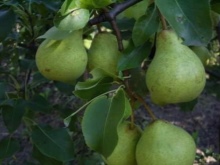
Useful Tips
Here are some helpful tips for dealing with pear rust.
- If a fruit tree is sick with rust, the primary carrier of which is a juniper bush, they must be treated at the same time. Otherwise, reinfection may occur.
- If the first antifungal treatment of trees is planned, then this should always be done before the kidney swells.
- It is necessary to take into account the fact that it is not so easy to cope with rust just like that. Even if the plantings were completely cured of it, there is no guarantee that the fungal spores will not reactivate.
- Any chemical-based drugs should be purchased only in specialized stores. They must be used strictly in accordance with the instructions, which are usually indicated on the original packaging. It is not recommended to experiment with such compositions, since this can cause very serious harm to fruit plantings.
- Controlling the condition of the trees planted on the site, it must be borne in mind that rust does not always appear exclusively on the foliage. Often, the fungus sneaks under the bark. Trunks and branches that have been damaged by rust become very vulnerable to other dangerous parasites and insect pests.
- A moisture level of 85% is ideal for the active development of rust, as well as temperature values from +15 to +20 degrees Celsius.If the pear suffers from other diseases, then it will be more susceptible to rust.
- If the tree suffers from a persistent nutritional deficiency, it will also be more susceptible to rust marks on leaves and trunks.
- Before pruning fruit trees in the garden, you need to properly prepare the tools. They are pretreated with alcohol or other safe disinfectants.
- Particular care is recommended if copper or iron-containing preparations have been chosen to combat the fungal disease. If the concentration of such agents is too high, they can have a toxic effect on plants.
- Absolutely all treatments for the treatment or preventive protection of trees should be carried out in cloudy and dry conditions. This will not only protect crops from sunburn, but also prevent the applied formulations from being washed off by rainwater.
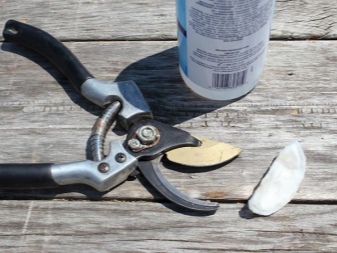














The comment was sent successfully.